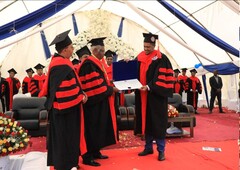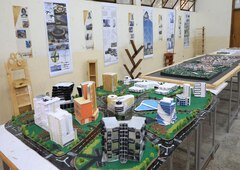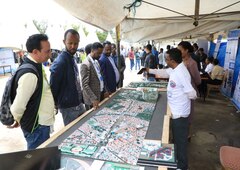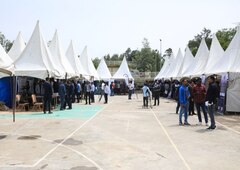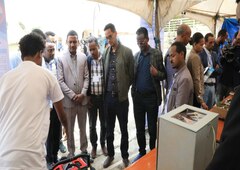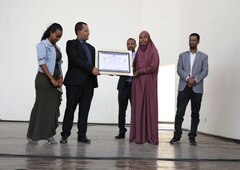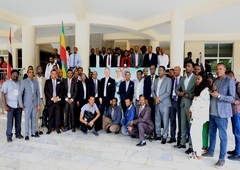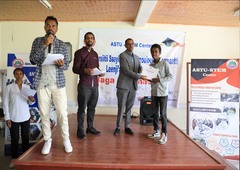The ASTU School of civil engineering and architecture is restructured on November 2014 containing eight programs namely: Structure Engineering, geotechnical Engineering, hydraulics & environmental Engineering, construction technology and management, irrigation Engineering and river basin development, Architecture, urban planning and design, geomatics Engineering. Currently, it comprise 4947 active UG students 140 academic staff member.
Vision
School of civil engineering and architecture, in line ASTU’s vision, aspires to become a leader player in the Ethiopian industrial Revolution with national recognition in delivering research based quality education, innovative and outstanding research based quality education, innovative and outstanding research findings, meaningful and wanted to support the development of the country.
Mission
The mission of the school is delivering the three pillars education (teaching learning, research, community service) at the highest possible cutting edge standard to the nation. These would include:
Delivering the highest quality education and training in science and technology and graduating fully capable engineers, who can design, operate, control, manage and execute and endeavor in their area of profession ethics and conduct.
- Providing education and training systems fully integrated and augmented by relevant research
- Serving as a center of excellence for science and technology in the field civil engineering industrial development
- Conducting applied problem solving research & providing consultancy and community service.
- Organizational Structure and Contact Address
Programs Description
Architecture is an art and science of designing buildings and other structures, and it deals with planning, designing and constructing form, space and ambience to reflect functional, technical, social, environmental and aesthetic considerations. It requires the creative manipulation and coordination of materials and technology, and of light and shadow. The practice of architecture also encompasses the pragmatic aspects of realizing buildings and structures, including scheduling, cost estimation and construction administration. Documentation produced by architects, typically drawings, plans and technical specifications, defines the structure and/or behaviour of a building or other kind of system that is to be or has been constructed. Architecture brings together the knowledge of art, science & technology and humanity for buildings and structures.
Urban planning is a technical and political process concerned with the use of land and design of the urban environment, including air, water, and the infrastructure passing into and out of urban areas such as transportation and distribution networks. It guides and ensures the orderly development of settlements and satellite communities which commute into and out of urban areas or share resources with it. It concerns itself with research and analysis, strategic thinking, architecture, urban design, public consultation, policy recommendations, implementation and management. Urban design is the process of designing and shaping cities, towns and villages. Whereas architecture focuses on individual buildings, urban design address the larger scale of groups of buildings, of streets and public spaces, whole neighbourhoods and districts, and entire cities, to make urban areas functional, attractive, and sustainable. Urban design is an inter-disciplinary subject that unites all the built environment professions, including urban planning, landscape architecture, architecture, civil and municipal engineering. Urban design demands a good understanding of a wide range of subjects from physical geography, through to social science, and an appreciation for disciplines, such as real estate development, urban economics, political economy and social theory.
Urban Planning & DesignUrban planning is a technical and political process concerned with the use of land and design of the urban environment, including air, water, and the infrastructure passing into and out of urban areas such as transportation and distribution networks. It guides and ensures the orderly development of settlements and satellite communities which commute into and out of urban areas or share resources with it. It concerns itself with research and analysis, strategic thinking, architecture, urban design, public consultation, policy recommendations, implementation and management.
Urban design is the process of designing and shaping cities, towns and villages. Whereas architecture focuses on individual buildings, urban design address the larger scale of groups of buildings, of streets and public spaces, whole neighbourhoods and districts, and entire cities, to make urban areas functional, attractive, and sustainable. Urban design is an inter-disciplinary subject that unites all the built environment professions, including urban planning, landscape architecture, architecture, civil and municipal engineering. Urban design demands a good understanding of a wide range of subjects from physical geography, through to social science, and an appreciation for disciplines, such as real estate development, urban economics, political economy and social theory.
Civil Engineering
Civil engineering is a professional engineering discipline that deals with the design, construction, and maintenance of the physical and naturally built environment, including works like roads, bridges, canals, dams, buildings etc. It is traditionally broken into several sub-disciplines including Structural Engineering and Geotechnical Engineering. Subjects related to structural engineering deals with the analysis and design of structures that support or resist loads. Structural Engineering is largely the implementation of mechanics to the design of the large structures that are fundamental to basic living, such as buildings, bridges, walls, dams, and tunnels. Structural engineering theory is based upon applied physical laws and empirical knowledge of the structural performance of different materials and geometries. Structural engineering design utilizes a number of simple structural elements to build complex structural systems. While subjects related to Geotechnical engineering associate with the behavior of soils under the influence of loading forces and soil-water interactions. This knowledge is applied to the design of foundations, retaining walls, earth dams, clay liners, and geosynthetics for waste containment. The goals of geotechnical engineers could range from the design of foundations and temporary excavation support, through route selection for railways and highways, to the increasingly important areas of landfill disposal of wastes and groundwater contamination. Geotechnical principles are important in civil engineering, but also has applications in military, mining, petroleum and other engineering disciplines that are concerned with construction occurring on the surface or within the ground.
Construction Technology & ManagmentConstruction Technology & Management is designed to deliver integrated technology and management of construction. While technology refers to methods or procedures of techniques applied to bring the best result, management is to plan, organize control and administer a number of different components such as resources, processes, desires, and their combined performance by using human and non-human energy in order to accomplish the optimum results. Construction management is mostly concerned with specifying project objectives and plans including delineation of scope, budgeting, scheduling, setting performance requirements, and selecting project participants, maximizing the resource efficiency through procurement of labor, materials and equipment, implementing various operations through proper coordination and control.
Geomatics EngineeringGeomatics engineering is a new information technology discipline in which engineers acquire, model, analyze, and manage spatially referenced information and apply the knowledge generated to a wide variety of functions. It uses terrestrial, marine, airborne, and satellite-based sensors to acquire spatial and other data. It then transforms the data into common information systems such as mapping or global positioning systems (GPS) with well-defined accuracy characteristics. Using satellites and other modern techniques, Geomatics engineers help airplane pilots to navigate the skies with increased safety; geophysicists to find underground petroleum reservoirs; and rescue teams to locate ships, aircraft, and land vehicles in distress. Geomatics engineers also monitor environmental problems by remote sensing, align high-precision large industrial machinery, manage computer-based information systems for land inventory and management, and monitor the stability of large structures using highly accurate positioning techniques.
Water resources engineering is an important discipline of engineering that affects the life of every human being since it deals with the important issues related to water. With a small quantity of fresh water available, the study of water resources engineering has become even more important. .
Water resources engineering generally deals with the provision of water for human use, and the development of techniques for the prevention of destruction from floods. Water resources engineering also includes the planning and management of facilities that are constructed for these tasks like making canals for irrigation and sewers for drainage and to avoid water logging, and all other issues related with the usage and control of water. To meet the water requirements of society and the environment, initially an estimate is carried out regarding the water available, the demand now and projected demand when the work will complete and future considerations, and then the requisite infrastructure is designed, including the water treatment plants and the pipes network, for the conveyance of water to the taps and waste water from the toilets to the treatment units. And also deals with development of designs for the various features which interact with water such as different types of dam, spillways and outlet works for dams, culverts for highways, canals and related structures for irrigation projects, and cooling-water facilities for thermal power plants. It is also concerned with environment protection such as ecological restoration, waste containment, soil remediation, and safe and efficient transportation.
The general programme objective is to educate professionals and scientists who contribute effectively to the development and management of water resources on both a local and global scale. The proposed programme provides multi-disciplinary and high-quality university education in the field of water resources engineering.





